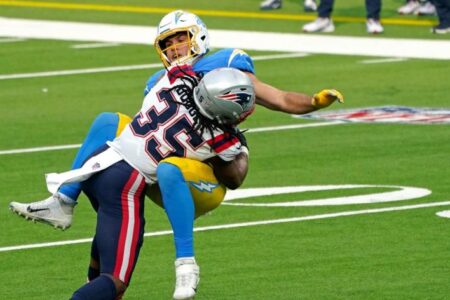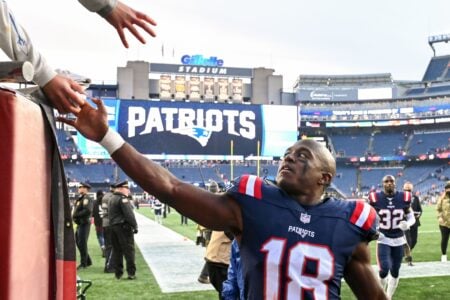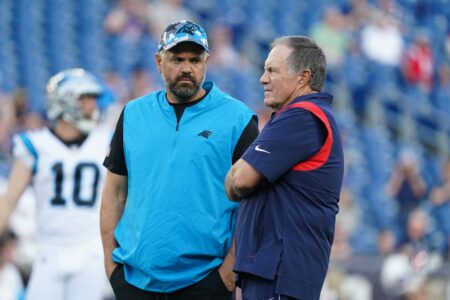PATRIOTS-80
2nd Team Getting Their First Start
- Joined
- Jul 30, 2005
- Messages
- 1,786
- Reaction score
- 0
Registered Members experience this forum ad and noise-free.
CLICK HERE to Register for a free account and login for a smoother ad-free experience. It's easy, and only takes a few moments.When we play 2 gap, 4-3, who sets the edge? In the 3-4 its the OLB. Is it the same in the 4-3?
The DE in a sense, because he's going to be out over the OT/TE. But the point in a 4-3 is to free the LBs to make the plays, moreso than setting an edge and having inside guys eat up the run. Instead, you use more men on the DL to free the LBs and allow them to get outside to make the play.
Makes sense, Guyton had some problems setting the edge with the OLB experiment last year. But with the DE over the OT/TE, I see Guyton making plays.
The DE in a sense, because he's going to be out over the OT/TE. But the point in a 4-3 is to free the LBs to make the plays, moreso than setting an edge and having inside guys eat up the run. Instead, you use more men on the DL to free the LBs and allow them to get outside to make the play.
And this plays to Mayo and Guyton's strength, in speed and open field tackling, with AD in sam (frequent blitzing)?
This is part of the misconception. Whether we align as a 34 or 43 the LBs have 2 gap responsiblity. When the play flows away, their responsibility is to step up into the cutback area.
Lbs 'free to chase' is a function of a one gap system.
But the DE is lined up on the T. The OLB is lined up on the TE and has edge responsibilities.
Its the OLB. The DE is lined up over the T in either 34 or 43.
They are responsible for the gap on either side.
"Setting the edge" means being the player responsible for the gap that extends to the sideline.
That is the OLB who has the gap on either side of the TE on the strong side, and either side of 'whoever shows' ie a pulling G or FB on the weakside.
An important aspect to watch for:
When our D is working optimally, and run designed to go T or out, including the stretch play, you will see the RB continue laterally all the way to the sideline as 2 players are in position to defend any gap he could chose. Ultimately he is run to the sidelines and the S and corner is up in run support and there is no or little gain, or even a loss from a RB who ust wont turn it upfield.
When its not working so well, the back is heading upfield before the numbers.
Strong side yes, weak side no. MLB also does not have to take on guards like in the 3-4.
But with more DL to tie up the OL, Mayo will be protected more? No?
In the 2 GAP, the DE has the responsibility for the C/D gaps.. The D gap is outside the Tight End.
Strong side yes, weak side no. MLB also does not have to take on guards like in the 3-4.
That is incorrect.
The reality is that in any 2 gap system (or 1 gap system) the gap assignments are going to vary based on a whole host of factors. The DE is not consistently going to have the responsibility for any particular gap, so there will be times when he has the D gap, and there will be times when he doesn't. Sometimes the OLB will have edge responsibility, other times he won't.
We are talking about the base and a standard alignment.
The DE lines up over the T and the OLB over the TE.
It was stated the other way around and that is not correct. We arent lining a 43 LB up to 2gap the T while playing the DE over the TE. That is just flat out wrong. Im trying to be nice, but its just incorrect.
Colts example: On a typical first down, DT Larry Triplett lines up in 1-technique on the weak side; fellow DT Monte Reagor lines up on the strong side in the 3-technique. DE Raheem Brock is over the tight end in a 6-technique, while Dwight Freeney is in the 7-technique, about 1.5 yards wide of the left tackle on the weak side.
Again, it really depends on precisely how a given defensive system operates. For example, from a very good article on defensive line play:
So while I don't spend a lot of time studying Colts film, if I am to believe the author of the article, then the Colts (at least in 2005) "typically" did line the DE up over the TE (wherever the LB ends up), which would give him the D gap. It really all depends on how precisely you've set up your system, and as a component of that exactly what the strengths of your players are (which leads you to set the system up in a given way).
The Colts are a one gap team. Specifically they are a team that askes their DL to rush the passer and if it happens to be a run, maybe find the RB along the way. I'm not shocked they align the DE as far outside as possible.
That is truly irrelevant to the 2 gap duties of a DE on the Patriots.
That's right. Sorry I'm falling asleep here posting this stuff.














